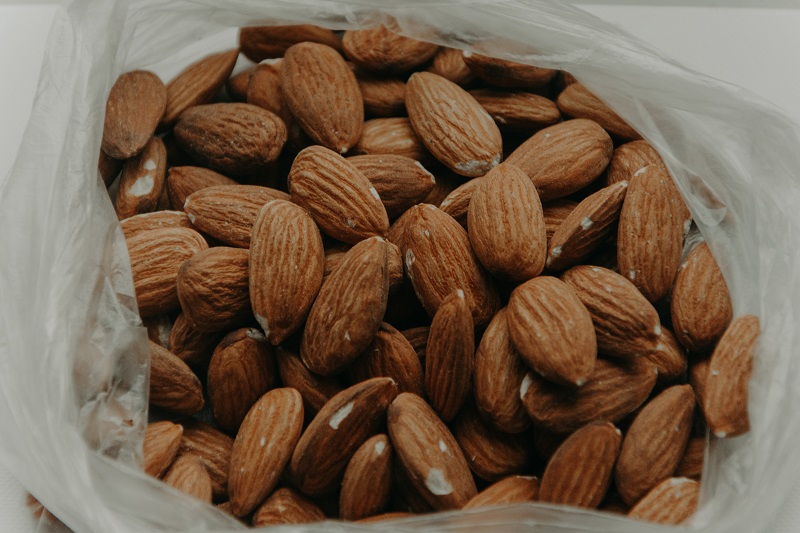The Most Problematic Weeds, Diseases, and Pests for Vegetable Growers
We’ve gathered advice from entomologists, weed scientists, and pathologists for years about how to identify and handle various pests and diseases in vegetable crops. Here’s what these experts had to say about the most problematic weeds, insects, and diseases, as reported by you in our 2023 State of the Vegetable Industry Survey.
Weeds
Pigweed: Mark VanGessel from the University of Delaware Research and Education Center: You can find the two problematic pigweed types throughout the U.S. They can cause significant loss in vegetable crops. Both are summer annual weeds that emerge in early spring, so they can be a particular problem for all spring-planted vegetables.
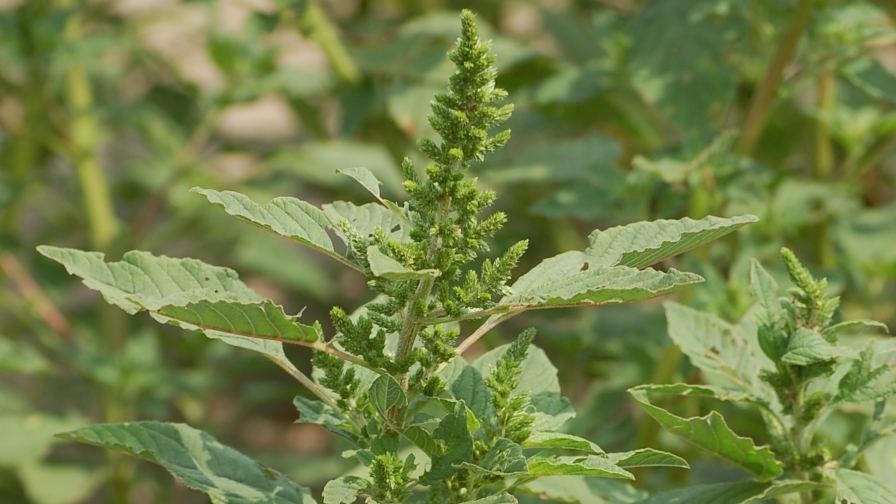
Herbicide-resistant smooth pigweed (redroot pigweed). Photo by Mark VanGessel.
Lambsquarter: Bernard Zandstra (Michigan State University) and Douglas Doohan (The Ohio State University): Common lambsquarter benefits from its enormous seed count per plant: an average of 72,500 seeds per plant, although it can reach as many as 176,000 seeds per plant.
Another factor to its resilience is longevity. Half of the seeds produced survive 12 years. One study showed 32% of seeds are still viable at 20 years, states Michigan State University’s profile on the weed.
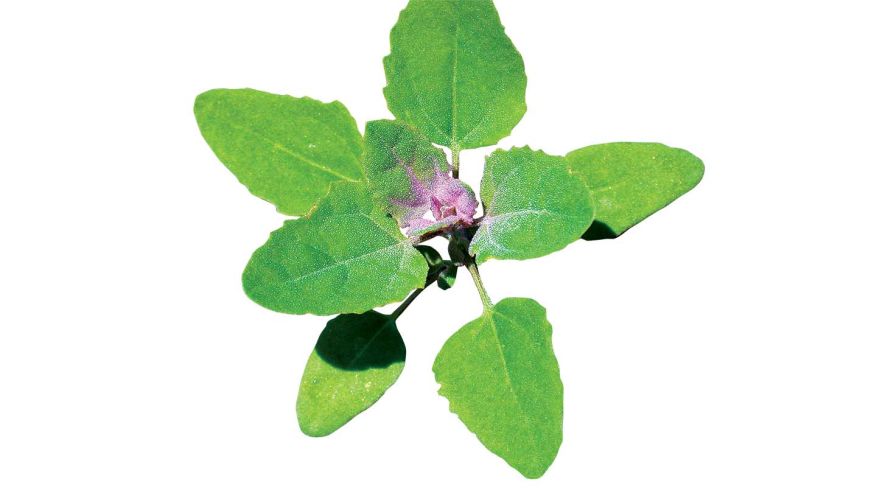
Seed dormancy increases with its depth within the soil. Complicating matters, seeds on the same plant have differing dormancy requirements. A range of combinations of light, temperature fluctuations, and soil nitrate levels can trigger a plant to break dormancy.
Economically, studies have shown there can be 13% yield loss in corn with just one lambsquarter plant per 1.5 feet. That jumps to a 48% yield loss in sugar beets with one plant per foot.
Yellow Nutsedge: Zandstra: Depending on the crop, Yellow nutsedge can reduce production to zero. If uncontrolled, there is total loss of crop. The weed competes with annual crops within two weeks of emergence, and it continues to compete all summer.
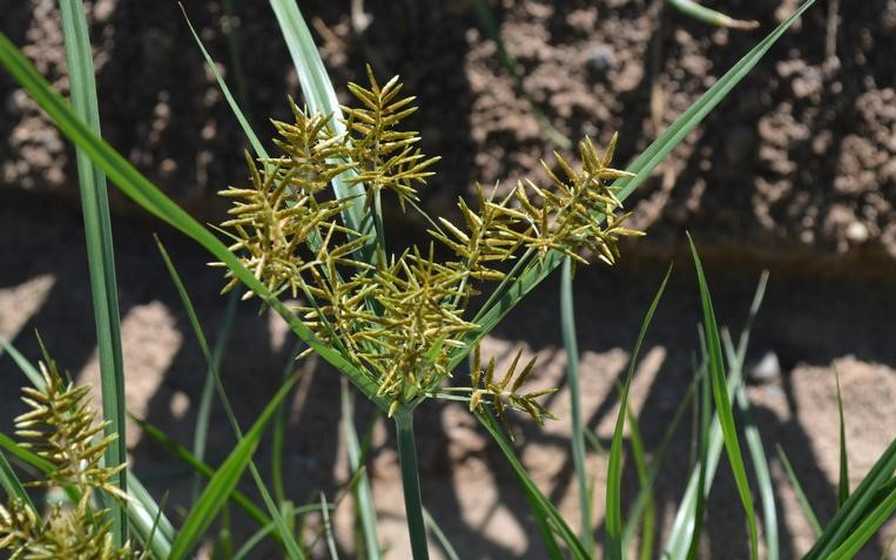
The seed-head-like flowers of yellow nutsedge can be deceptive. Yellow nutsedge’s biggest threat is its tuber.
Photo by Howard F. Schwartz
Nathan S. Boyd, Ph.D., University of Florida: Nutsedge is a perennial plant, so it is a problem at most growth stages. Obviously, the earlier it emerges, the greater a problem it will be. Overall, the weed’s impact is huge but difficult to quantify. Very little research has tried to quantify the economic impact, but growers across Florida frequently identify nutsedge as one of their key pests. It is one of only two weed species (purple nutsedge is the other) that can puncture the plastic mulch used in plasticulture vegetable production. This causes four distinct problems.
- Problem #1: It weakens the plastic and prevents growers from growing multiple crops on the same bed using the same mulch.
- Problem #2: It can get very thick and make plastic removal at the end of the season very difficult. This adds a lot to labor costs.
- Problem #3: It makes harvests of low growing crops (strawberries, etc.) difficult because it hides the fruit.
- Problem #4: It competes with crops for light and nutrients. Effects on yield vary substantially from crop to crop.
Diseases
Downy Mildew: Mary K. Hausbeck and Sheila D. Linderman, Michigan State University: Downy mildew is well-known for causing catastrophic losses in a brief period of time. It spreads to surrounding fields on air currents via tiny, microscopic spores that act as seeds of the pathogen. Cool (~ 60°F), wet, and cloudy conditions create an ideal environment for DM spores to survive outside the host.
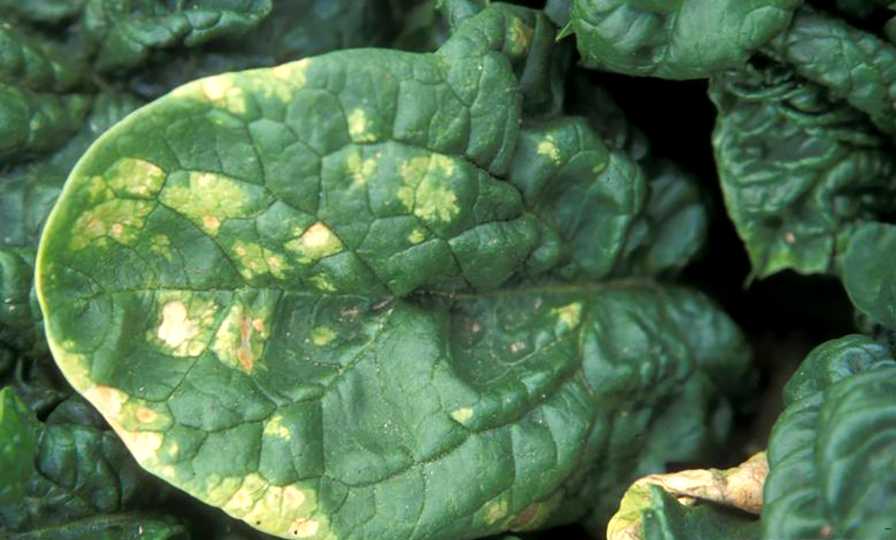
Downy mildew on spinach. Photo by Gerald Holmes
When the conditions are favorable, unprotected foliage can become completely blighted within 14 days of the initial infection, resulting in catastrophic yield losses.
Cosmetic issues can have an impact as well, with sunscald giving fruit a less than desirable rind color. For pumpkins, handles/stems can be an important factor in purchasing decisions for consumers.
Powdery Mildew: Anthony Keinath, Clemson University: Powdery mildew can reduce watermelon yields directly by causing the plants to produce fewer fruit, and indirectly by killing leaves that shade the fruit, leading to sunburn. The losses can be up to $1,500 per acre, or 75% of the value of the crop. Powdery mildew also can cause pumpkins to set fewer fruit, delay fruit ripening, and cause the handles to be soft, so they don’t hold up when the fruit are sold.
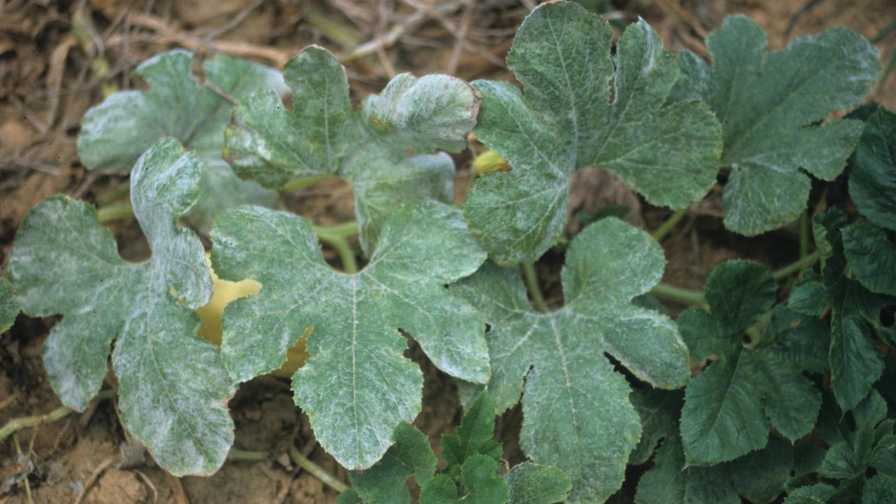
Powdery mildew on squash. Photo by Gerald Holmes
Insects
Thrips: John C. Palumbo, Professor and Extension Specialist, University of Arizona: Western flower thrips (WFT), a major pest in winter leafy vegetable crops grown in Arizona and Southern California, has the potential to cause cosmetic damage to all lettuce cultivars throughout the growing season, and particularly at harvest if not managed properly.
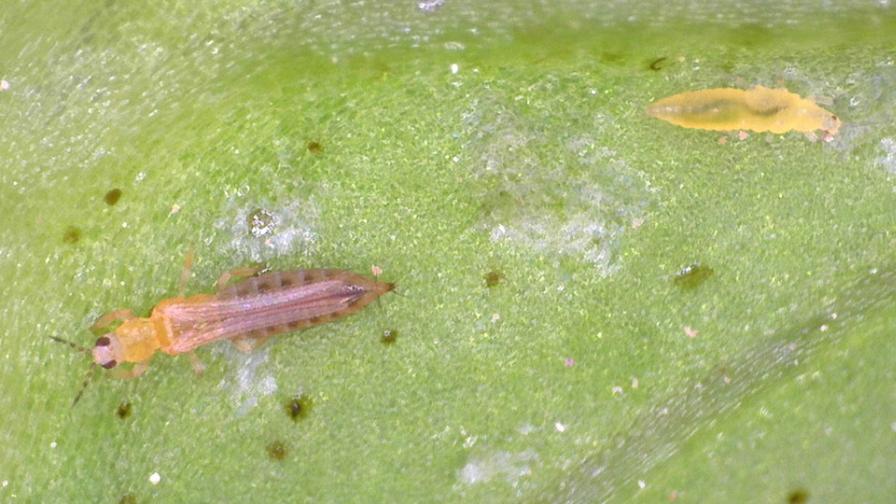
Western flower thrips adult (left) and larva (right) feeding on lettuce.
Photo by John Palumbo
Both adults and larvae cause economic feeding damage in lettuce and spinach. High populations of WFT can result in significant blemishes on marketable leaf portions of lettuce, and baby spinach crops are susceptible to thrips damage on the young, terminal growth, because as leaves expand and elongate, they become scarred and distorted. And if cosmetic feeding damage is excessive, the entire crop can be rejected. Also, the presence of live thrips can contaminate the harvested product.
WFT is also a vector of impatiens necrotic spot virus (INSV) in lettuce, which has recently caused significant economic losses to lettuce crops in the Salinas Valley. To date, INSV has had minimal impact on lettuce in the Desert Southwest.
Spider Mites: Andrew Muza, Extension Educator, Pennsylvania State University: Two-spotted spider mites feed mainly on the undersides of leaves. Spider mites puncture leaf tissue and extract chlorophyll and plant sap from cells causing white-yellowish, pinpoint dots (stippling/speckling) on the upper leaf surface. Extensive feeding by high populations of mites can cause yellowing and browning of leaves, premature leaf drop, and a reduction in plant vigor.
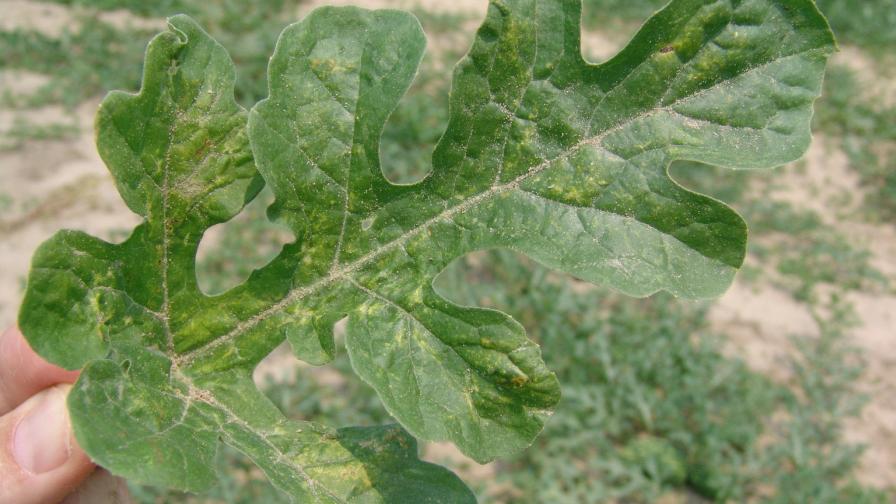
Spider mites require a glass bug lens to be spotted visually when scouting. Symptom damage appears as yellowing, white, or rust spots on leaves.
Photo by Gerald Holmes
The Top Pests and Diseases for Organic and Conventional Vegetable Growers
When you compare the biggest headaches for both organic and conventional vegetable growers, there is a lot of overlap. In weeds, the line up is very similar, although nutsedge tied for first for organic growers. Weeds and diseases are a bit more diverse.
Organic Growers
- Weeds
Pigweed (tie)
Nutsedge (tie)
Lambsquarter
- Disease
Downy mildew
Powdery mildew
Fusarium
- Insects
Thrips
Spider mites
Flea beetle
Conventional Growers
- Weeds
Pigweed
Nutsedge
Lambsquarter
- Disease
Powdery mildew
Downy mildew
Phytopthera
- Insects
Thrips
Corn earworm
Spider mites
Source: American Vegetable Grower’s 2023 State of the Vegetable Industry Survey







